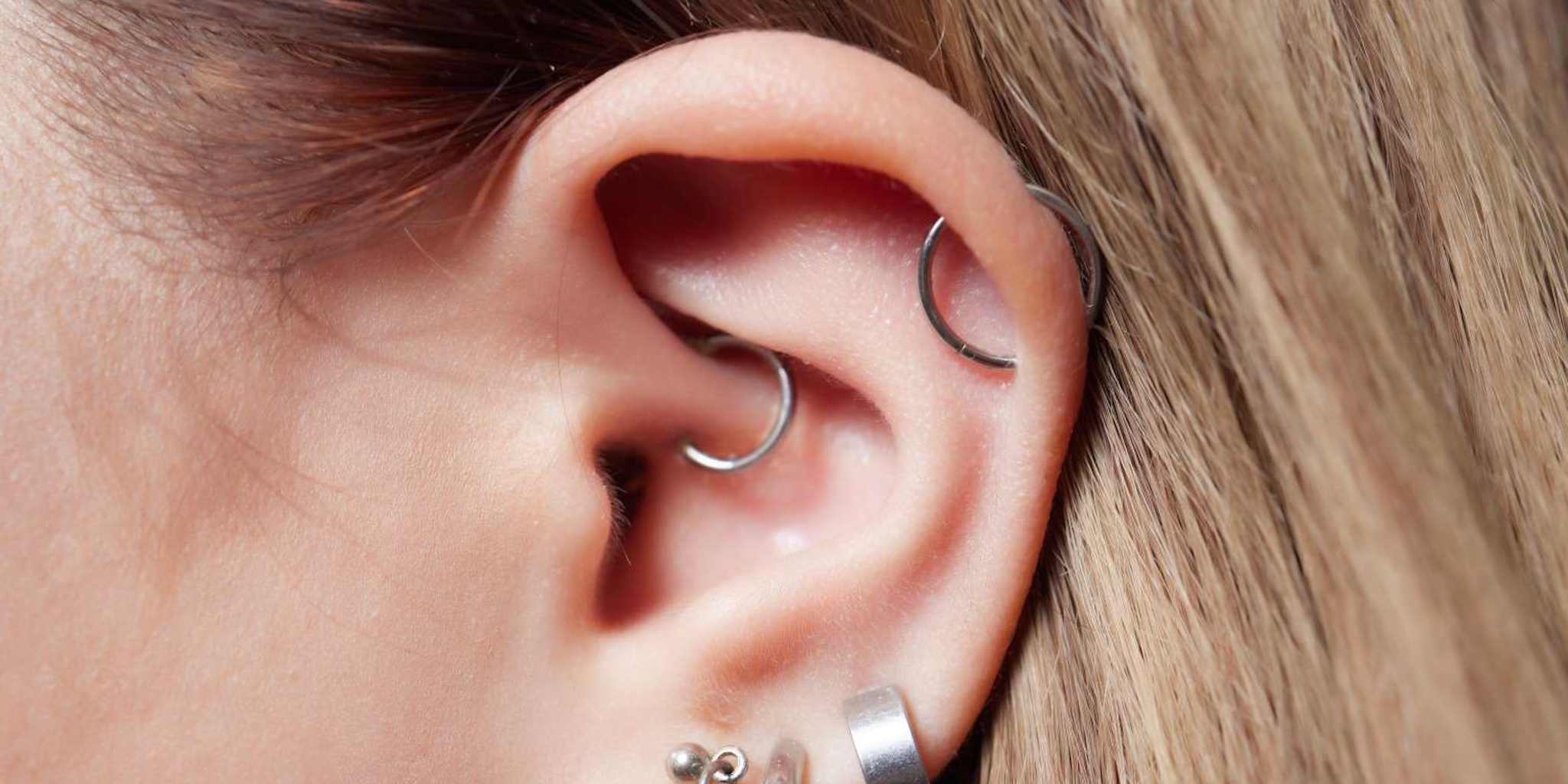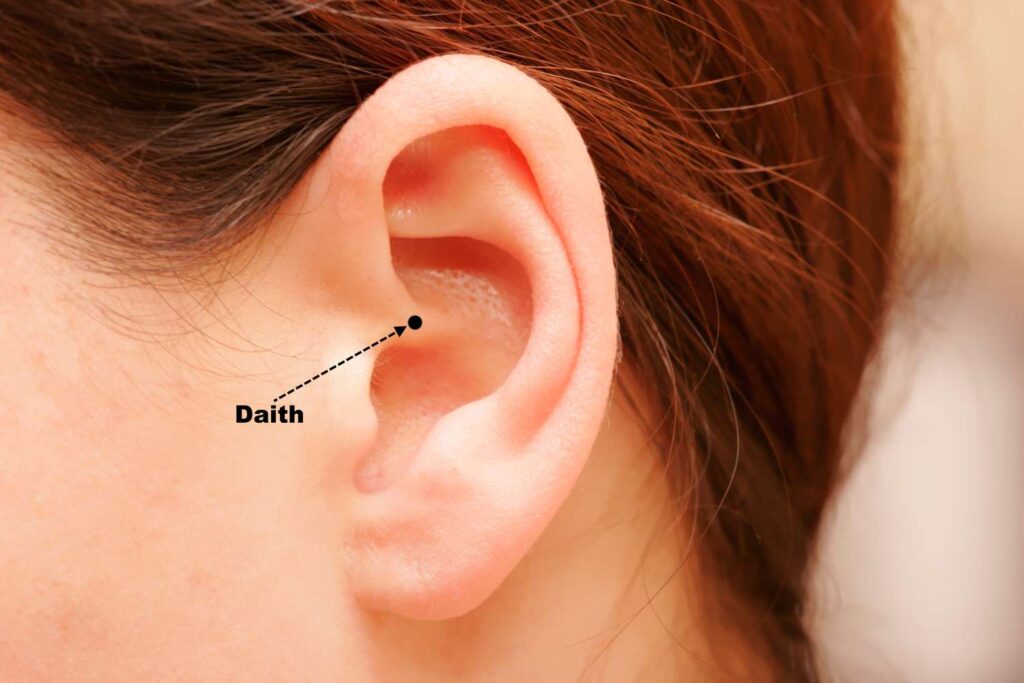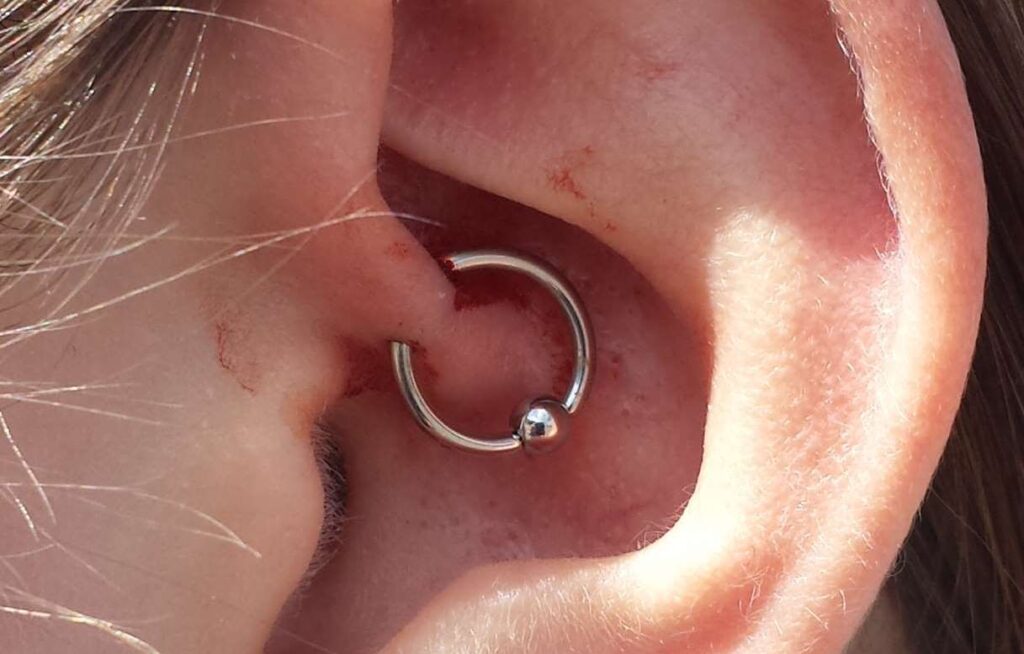
Join The Piercing Ya Newsletter
Daith Piercing: Cutting Through The Intricate Details
Daith Piercing Article Quick Reference:
History | Myths | Complications | Pain | Cost | Procedure | Healing | Aftercare | Jewelry | Celebrities
Hey there, fellow piercing enthusiasts – have you heard about the secret inner circle of the ear piercing world? It’s called the daith ear piercing – and boy, is it cool.
This piercing is located in the innermost fold of the ear, in the area where the helix meets the outer edge of the ear and swoops in towards your ear canal. It’s like finding a hidden treasure in your own body – a body secret if you will.
Check out the exact location in the diagram below.

A DAITH SHORT HISTORY
Let me tell you some history about this cool piercing! We might not know exactly where it came from – maybe some alien planet, who knows – but we do know that it’s been popular in the US since the late 90’s. Though it may be a baby compared to other piercings, it has made quite the impact on fashion and wellness trends over the last almost 25 years!

MISLEAD BY EAR-SAY?
Alright, all you daith piercing dreamers, listen up – there are some rumors out there that need to be busted! Here are some of the biggest myths surrounding this edgy ear beauty:
- It Can Cure Migraines: Many people believe the daith piercing can cure migraines, but no scientific evidence supports this claim. While some have reported relief from migraines after getting the piercing, the placebo effect rather than any real therapeutic benefit could explain this.
- It’s A Dangerous Piercing: The daith piercing might sound intimidating, but it’s no riskier than any other cartilage piercing. Just make sure to take proper care of it – or else you’ll risk joining the unlucky few with a nasty infection.
- It’s A Painful Piercing: Let’s be real here – shoving a needle through any part of your body will sting a little. But it feels more like a quick, sharp pinch than getting a thumbtack jammed in your ear. Don’t worry, everything will be ok in the end.
- It’s A Difficult Piercing To Heal: While the daith piercing is located in a sensitive area of the ear, proper aftercare can help to ensure a smooth healing process. It’s important to follow the aftercare instructions provided by your piercer and to keep the area clean and dry.
WHO LIKES THE DAITH BEST?
The daith piercing is a popular choice among people of different ages and sexes. Many young adults and teenagers have this piercing, but it is also common among people in their 20’s and 30’s.
That’s right, whether you’re just a bright-eyed youngster or a full-fledged adult – the daith piercing is here for you. There is no official age recommendation or limit for the daith piercing, but most reputable shops and piercers require clients to be at least 16-18 years old. Younger individuals may require parental permission and supervision.
Regarding gender, the daith piercing is relatively gender-neutral, and both men and women get it. However, it’s worth noting that some people still associate certain piercings with specific genders, so cultural and regional variations may exist.
Overall, the daith piercing is a versatile option that can appeal to anyone interested in body piercing, regardless of their age or gender identity.
DAITH EAR-SSUES: RISKS
Let me tell you, a daith piercing is not all sunshine and rainbows. Like any other body piercing, there are risks and potential issues that you need to keep in mind. Here are some of the most common ones:
- Infection: If you don’t get your piercing done in a nice, clean, and germ-free environment, then you might have a fun, little bacteria party on your ear. Watch out for redness, swelling, and discharge.
- Pain And Tenderness: The ear may be sore and tender for a few days after the piercing is done.
- Allergic Reactions: Some folks may not be friendly with the metal used for the jewelry. Watch out for itching, redness, and swelling.
- Keloid Scarring: In some cases, the body may produce excess scar tissue, which can result in a raised, bumpy scar.
- Embedded Jewelry: In some rare cases, the jewelry might get so attached to your ear that it might never want to leave. Think of it like a clingy ex, but in your ear.
- Excessive Bleeding: A little bit of blood here and there is standard, but if your ear starts resembling a crime scene, it’s probably time to phone a friend (or a medic).
To make this daith-piercing adventure a success, make sure that you choose a savvy piercer who uses the finest sterile equipment and follows proper aftercare instructions. And if things go south, then don’t be shy to scream for help (it’s your right!).
ALSO THE COMPLICATIONS:
Did you think knowing those risks was all you needed before getting a daith piercing? Well, well, well, not so fast! Consider these additional health-related issues before you dive into the world of daiths:
- Immune System Disorders: If you’re feeling a bit weak, hiding from the sun like a vampire, or feeling like you’ve been fighting shadows, then it might be a sign of a weakened immune system. That can make you more susceptible to infections and make the piercing process a bit of a hassle.
- Bleeding Disorders: If you have trouble stopping the blood flow after a paper cut, then you might want to think twice before getting a daith piercing. The piercing process itself will involve a bit of bleeding, and you don’t want to become the star of your very own horror movie.
- Skin Conditions: Skin conditions such as eczema or psoriasis can increase the risk of infection or delay healing after the piercing.
- Diabetes: Got diabetes? People with diabetes may be at higher risk of developing infection and may take longer to heal.
Remember, it’s always important to inform your piercer about any underlying health conditions you might have before getting a piercing. And if you have any worries, consult with your healthcare provider before taking the plunge – better to be safe than sorry!

DAITH TODAY, GONE TOMORROW (OR NOT)
The length of time you can leave the piercing without jewelry entirely depends on how well the piercing has healed. While you can leave some piercings without jewelry for extended periods, others may start to close after just a few days.
You can reverse or remove the daith piercing entirely, but this depends on the individual’s body and the extent of scarring or damage from the piercing. Some individuals may experience permanent changes to the shape or contour of their ear as a result of the piercing.
FROM PERKY EAR TO PIERCING FEAR: OHH THE PAIN
Want to get the daith piercing? Great! That’s gonna be one heck of an adventure as that piercing goes right through some thick ear cartilage, meaning you might be in for a bit of an ordeal. Don’t you worry though my friend!
Here are a few tips for how to deal with the pain and discomfort during and after the process:
- Deep Breathing: Take some deep breaths to prevent yourself from going into total freak-out mode.
- Ice Pack: Pop an ice pack or cold compress onto your ear for a few minutes before the piercing to numb everything up and minimize the ouch.
- Pain Relievers: Takin’ some over-the-counter meds like ibuprofen or acetaminophen comes highly recommended. But, like, follow the instructions on the box to the letter, or your doctor will not be pleased!
- Aftercare Tips: Following the recommended aftercare instructions provided by your piercer to promote healing and alleviate any pain or discomfort during the healing process.
- Now, here’s the thing, you need to make sure you go to an experienced and reputable piercer to make sure everything goes smoothly. If not, you could be in some serious hot water with prolonged healing times and all kinds of yucky infections. To make your experience less painful, it’s also pretty crucial to take good care of your new piercing during the healing process.
- Always remember: No pain, no gain! (But let’s at least try to keep things manageable, shall we?)
DAITH PIERCING COST: EAR-TAINLY NOT CHEAP
The cost of a daith piercing can vary wildly based on lots of things, like where you’re located, how experienced your piercer is, or even the radiant quality of your jewelry. Expect to shell out between a reasonable $40 and $100 in the United States. But hold on to your earlobes! If you happen to be in NYC or Los Angeles, for example, you might face charges ranging from $60 to $120, so consider living somewhere cheaper, like on a deserted island or the moon.
On the flip side, those who live in rural areas or smaller cities might rejoice to know that they may spend as little as $30 to $80, depending on the piercer and level of care.
It’s essential to choose a reputable and experienced piercer. A reputable piercer ensures the completion of the correct step-by-step process.. Also, it reduces the risk of complications that cause prolonged healing. It’s also crucial to take good care of your piercing during the healing process to prevent infections, irritation, and further discomfort.
DAITH PIERCING: THE NOT SO EASY PEEZY PROCEDURE
First thing’s first: The gauge of the needle used for a daith piercing ranges from 16 to 18. However, your specific needle size may vary depending on your piercer’s vibe and your ear’s anatomy.
Since we’ve got that squared away, here’s what you can expect when you’re getting a daith piercing:
- Consultation: We’ll start with a good old chinwag about your aspirations for your piercing. Your piercer will walk you through the ins and outs of the piercing process, scope out your ear, and answer all your burning questions.
- Preparation: First, your piercer will scrub-a-dub-dub their hands and your ear for a sparkly clean start to the piercing. They’ll then mark the exact spot for your piercing with a super hygienic pen.
- Piercing: The piercer uses a clamp and to keep the ear in place. They then push a steralized needle through the ear’s cartilage. Some piercers may use a small receiving tube to help guide the needle through the ear.
- Inserting Jewelry: Once the needle has passed through the ear, the piercer will quickly insert the jewelry and secure it in place.
- Cleaning And Aftercare: The whole ordeal will finally culminate in some much-needed cleaning. The piercer will a saline solution or antiseptic. They then offer you some detailed aftercare instructions, including. This includes how to clean your new piercing after you leave and what to expect during the healing process.
Oh, and before I forget, some piercers prefer a cannula needle instead, which allows them to put the jewelry in while the needle stays put. This can reduce any discomfort and trauma to your ear tissue during the piercing process, which can be pretty nifty. Good luck!
HEALING TIME FROM PIERCED EAR TO PAINLESS CHEER
The healing period for a daith ear piercing can be pretty unpredictable. A lot of factors come into play, including your general health, how well you look after your piercing, and even where it’s pierced in the first place. Expect to be in healing mode for anywhere from six to twelve months.
EAR-SOME AFTERCARE TIPS FOR THE DAITH PIERCING
Alright, now that you’ve got your daith piercing, it’s time to talk aftercare! Don’t worry, it’s no rocket science. Here are some general guidelines to make you feel more comfortable:
- Cleaning: So, you’ll need to regularly clean the area with a saline solution or antiseptic recommended by your piercer, but be gentle. You don’t want to traumatize your poor ear.
- Avoid Touching: Think your piercer’s hands were the only clean ones in town? Now’s the time to make sure your mitts are spotless too. Avoid exposing your piercing to harmful chemicals like hairspray and body lotion.
- Sleeping: Avoid sleeping on the side with the piercing to prevent irritation or trauma to the area.
- Keep an Eye On Your Piercing: Be sure to monitor your daith regularly for signs of infection. These signs include swelling, redness, etc., and seek medical attention if you need it.
- Maintain A Healthy Diet: Eating a balanced diet that is rich in nutrients like vitamin C can help boost the immune system and promote faster healing.
- Avoid Smoking And Alcohol: When it comes to smoking and alcohol, it’s best to give them a miss. They can slow down the whole healing process and even bring some unwanted infections to the party.
Stick to these tips for your piercing aftercare, and watch how much happier your healing process becomes.
CHANGING OUT THE GOODS
By recommendation, wait until the daith piercing fully heals before changing the jewelry. During this time, it’s essential to follow proper aftercare instructions provided by the piercer to promote healing and prevent infections or other complications.
Once the piercing has fully healed, you can consider changing the jewelry if desired. However, you should do so gradually to minimize the risk of trauma or damage to the tissue around the piercing. Also, choosing high-quality jewelry is recommended to reduce the risk of an allergic reaction or irritation.
If you’re not sure where to start, or if you’re feeling any discomfort or irritation, don’t hesitate to take advice from a professional piercer. They can assist you in changing your jewelry safely and provide excellent recommendations on what jewelry designs may complement your ear. So, go ahead and show off your style with confidence, but proceed with caution!
WHAT JEWELRY MATERIALS ARE BEST?
When you’re jazzing up your daith piercing, don’t forget to give some thought to the jewelry you use. You don’t wanna end up with something that’ll make your body regret it later! Here are some materials to keep in mind:
- Surgical Steel: It’s tough and hypoallergenic, perfect for those delicate skin types.
- Titanium: Light and corrosion-resistant, cool for those who don’t want anything weighing them down.
- Gold: Gold can be a good option for daith piercings, but it’s essential to ensure that the gold used is at least 14 karats, as lower grades may contain nickel that can cause allergic reactions.
- Bioplast: A plastic made for your bod! It’s gentle and flexy, amazing for avoiding metal allergies or sensitivities.
If you’re tempted to bling out with some cheapo type jewelry, don’t. That stuff might have harmful substances that will make your piercing unhappy. Always get your goods from a trustworthy source. Moreover, you want it marked specifically for body piercings. No improvising!
ROCKIN THE STYLES?
There are many different styles of body jewelry that can be used in a daith piercing, depending on personal preference and anatomical considerations. Here are some popular types of jewelry used for daith piercings:
- Hoops: Hoop earrings are a popular choice for daith piercings. They come in various sizes, shapes, and materials, making them versatile and easy to customize.
- Circular Barbells: Horseshoe-shaped barbells, commonly used in many types of body piercings including daith piercings, come in various gauges and lengths and can feature decorative elements like beads or gems.
- CBR’s: CBRs, or captive bead rings, are another popular option for daith piercings. They are circular in shape, with a small bead that must be “captured” within the ring to keep it in place. They come in a variety of diameters, gauges, and materials.
- Clickers: Clickers are a relatively new style of body jewelry that has become increasingly popular in recent years. They are designed to “click” into place, creating a secure and comfortable fit. They can be made from various materials and decorated with gems or other embellishments.
- Segment Rings: These are circular rings that are designed to look like a solid circle when closed. They can be made from various materials and come in a range of diameters and gauges.
When you’re picking your style, remember size matters, folks! Too small is uncomfortable, and too big is just asking for trouble. Plus, the smoother, the better – nobody wants extra trauma to their poor ear tissues.
CELEBS FLAUNTING THEIR DAITH PIERCING
If you’re thinking about spicing up your ears with a daith piercing, you’re not alone. Check out these famous folks who are rocking them:
- Zoe Kravitz: The American actress and singer has a daith piercing in her left ear.
- FKA Twigs: The British singer, songwriter, and dancer has a double daith in her right ear.
- Scarlett Johansson: The American actress has a daith in her right ear.
- Rihanna: The Barbadian singer and entrepreneur has a daith piercing in her right ear.
- Katy Perry: The American singer and songwriter has a double daith piercing in her left ear.
- Emma Watson: The British actress has a daith in her left ear.
- Bella Thorne: The American actress, singer, and director has a daith piercing in her left ear.
- Jenna Dewan: The American actress and dancer has a daith piercing in her left ear.
- Nicole Richie: The American fashion designer, actress, and television personality has a daith in her right ear.
Now, just remember to think it through, friends. Getting a daith is a personal choice, and it ain’t nothing to mess with. Don’t skip the homework on risks and aftercare before you commit!
SO, DO YOU WANT A DAITH PIERCING?
The daith piercing is a trendy and fashionable way to upgrade your ear game. From the piercing procedure to the healing time and aftercare, it is important to follow proper protocol. The cost and jewelry options for the daith piercing can range from minimal to maximal, so you can choose what works best for your budget and style. And if you’re looking for some celebrity inspiration, there are plenty of big names out there that have rocked the daith piercing with confidence. So go ahead and embrace the daith ear piercing trend and enjoy your new eye-catching piercing!
Need to find a piercer? Check out the Association of Professional Piercers.
Author: Scott S.
